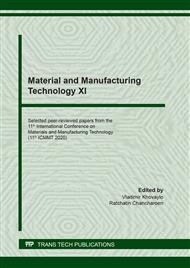p.102
p.108
p.114
p.123
p.131
p.141
p.147
p.153
p.160
Impact of Partial Replacement of Brick Coarse Aggregate by Waste Rubber Tyre on the Fresh and Hardened Properties of Concrete
Abstract:
This study focused on the feasibility of utilizing waste rubber tyre as coarse aggregate in concrete as a partial replacement of brick aggregate (BA). Within this context, fresh and hardened properties were investigated on concrete made with three different percentage replacements (0, 10 and 20% by volume) of BA by waste rubber tyre aggregate (WRTA). The WRTA was washed with tap water (H2O) and treated with 20% sodium hydroxide (NaOH) for 2 hours. It was found that the workability and dry density of concrete decrease with an increasing percentage of WRTA. In case of mechanical properties, the compressive strength decreases with the increasing content of both treated and untreated WRTA. The maximum decrease was observed for 20% of both treated and untreated WRTA, which was 41-46% for treated and 47-54% for untreated lower than the reference concrete for all curing ages. It was observed that the concrete made with tyre treated with NaOH provides better strength than untreated tyre aggregate. This behavior could be attributed to the better bonding between cement paste and rubber aggregates as a result of the increased surface roughness by NaOH.
Info:
Periodical:
Pages:
131-137
Citation:
Online since:
February 2021
Price:
Сopyright:
© 2021 Trans Tech Publications Ltd. All Rights Reserved
Share:
Citation:


